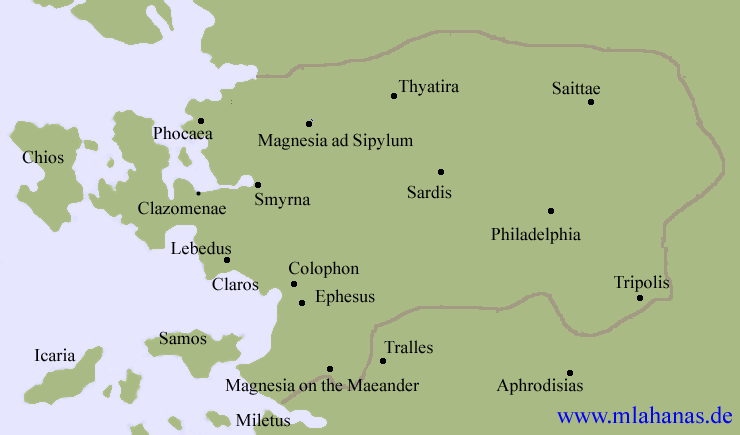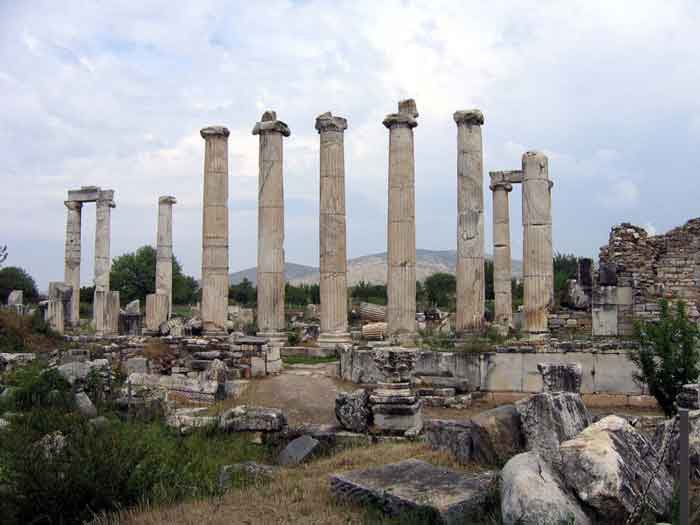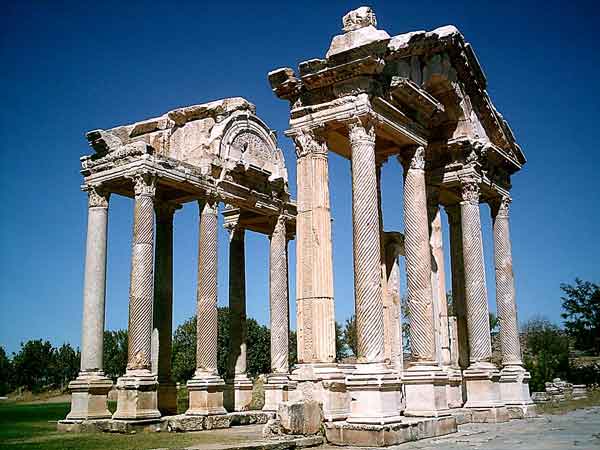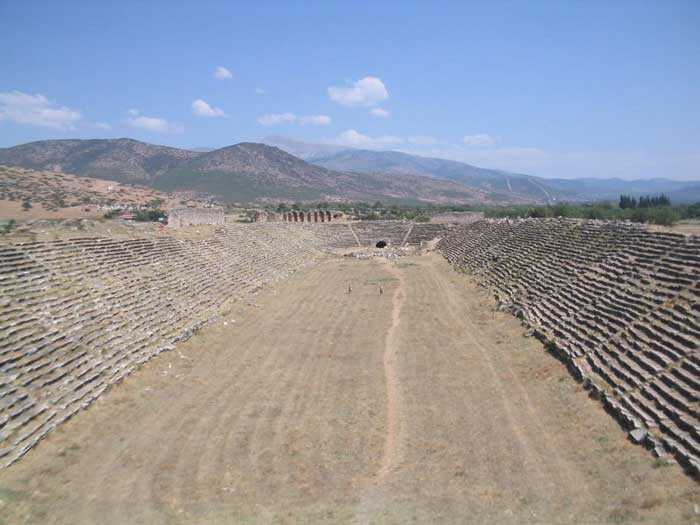.

Aphrodisias was a town in Caria, now part of modern Turkey, about 230 km (142.5 miles) from Izmir, located beside the modern village of Geyre (see Google Maps). As its name implies, it was named after Aphrodite, the Greek goddess of Love. According to the Suda, before being known as Aphrodisias, the city had three previous names: Lelegon Polis (city of the Leleges), Megale Polis, and Ninoë.
The city was built near a marble quarry, which was extensively exploited in the Hellenistic and Roman periods, and sculptors in marble from Aphrodisias became famous in the Roman world. Many examples of statuary have been unearthed in Aphrodisias, and some also survive from other parts of the Roman world.
The most recent excavations were begun by Kenan Erim under the aegis of New York University in 1962 and are ongoing, currently led by Professor Christopher Ratté (at NYU) and Professor R.R.R.Smith (at Oxford University). Previously the site was excavated in 1904-5 by a French railroad engineer, Paul Gaudin. As many pieces of monumental stone were reused in the Late Antique city walls, many inscriptions could and can be easily read by visitors to the area without any excavation; the city has therefore been visited and insciptions recorded repeatedly in modern times, already from the early eighteenth century.
The site is in an earthquake zone and has suffered a great deal of damage at various times, especially in the 4th and 7th centuries. An added complication was that one of the 4th century earthquakes altered the water table, making parts of the town prone to flooding.
Evidence can be seen of emergency plumbing installed to combat this problem. Aphrodisias never fully recovered from the 7th century earthquake, and fell into disrepair. Part of the town was covered by the modern village of Geyre; some of the cottages were removed in the 20th century to reveal the older city. A new Geyre has been built a short distance away.
Temple of Aphrodite

Temple of Aphrodite (Source)

The tetrapylon (monumental gate). Photo M. Chloe Mulderig
Temple of Aphrodite
The Temple of Aphrodite was and still is a focal point of the town, but the character of the building was altered when it became a Christian basilica. The Aphrodisian sculptors became renowned and the school of sculpture was very productive; a lot of their work can be seen around the site and in the museum. Many full-length statues were discovered in the region of the agora, and trial and unfinished pieces pointing to a true school are in evidence. Sarcophagi were recovered in various locations, most frequently decorated with designs consisting of garland and columns. Pilasters have been, found showing what are described as "peopled scrolls" with figures of people, birds and animals entwined in acanthus leaves. The sculptors benefitted from a plentiful supply of marble close at hand.
Other buildings

The stadium (Source)
There are many other notable buildings, including the stadium which is said to be probably the best preserved of its kind in the Mediterranean. It measured 262 by 59 m and was used for athletic events until the theatre was badly damaged by a 7th century earthquake, requiring part of the stadium to be converted for events previously staged in the theatre.
Inscriptions of Aphrodisias
The quality of the marble in Aphrodisias has also resulted in an unusually large number of inscribed items surviving in the city. Upwards of 2000 inscriptions have been recorded by the New York excavators, many of them re-used in the city walls. Most inscriptions are from the Imperial period, with funerary and honorary texts being particularly well-represented, but there are a handful of texts from all periods from the Hellenistic to Byzantine.
Excavations in Aphrodisias uncovered an important Jewish inscription whose context is unclear. The inscription, in Greek, lists donations made by numerous individuals, of whom several are classed as 'theosebeis', or Godfearers. It seems clear through comparative evidence from the inscriptions in the Sardis synagogue and from the New Testament that such Godfearers were probably interested gentiles who attached themselves to the Jewish community, supporting and perhaps frequenting the synagogue. The geographical spread of the evidence suggests this was a widespread phenomenon in Asia Minor during the Roman period.

Young Centaur, Musei Capitolini MC656, Aristeas and Papias of Aphrodisias
Persons
- Alexander of Aphrodisias
- Chariton of Aphrodisias
- Aristaias of Aphrodisias, sculptor
References
- Sheila Campbell: The mosaics of Aphrodisias in Caria. Pontifical Inst. of Mediaeval Studies, Toronto 1991, ISBN 0-88844-367-6.
- Kenan T. Erim: Aphrodisias. City of Venus Aphrodite. Muller, Blond & White, London 1986, ISBN 0-584-11106-1.
- David MacDonald: The coinage of Aphrodisias. Royal Numismatic Society, London 1992, ISBN 0-901405-30-2.
- Joyce Reynolds: Aphrodisias and Rome. Documents from the excavation of the theatre at Aphrodisias. Society for the Promotion of Roman Studies, London 1982, ISBN 0-907764-00-2.
- Charlotte Roueché: Aphrodisias in late antiquity. The late Roman and Byzantine inscriptions including texts from the excavations at Aphrodisias conducted by Kenan T. Erim. Society for the Promotion of Roman Studies, London 1989 (Journal of Roman studies monographs, 5), ISBN 0-907764-09-6.
- Revised second edition 2004 online
Links
- History of Aphrodisias, birth place of the goddess of love
- Aphrodisias (http://www.nyu.edu/projects/aphrodisias/home.ti.htm)
Greece :
A - B - C - D - E - F - G - H - I - J - K - L - M -
N - O - P - Q - R - S - T - U - V - W - X - Y - Z
| Ancient Greece
Science, Technology , Medicine , Warfare, , Biographies , Life , Cities/Places/Maps , Arts , Literature , Philosophy ,Olympics, Mythology , History , Images Medieval Greece / Byzantine Empire Science, Technology, Arts, , Warfare , Literature, Biographies, Icons, History Modern Greece Cities, Islands, Regions, Fauna/Flora ,Biographies , History , Warfare, Science/Technology, Literature, Music , Arts , Film/Actors , Sport , Fashion --- |
Retrieved from "http://en.wikipedia.org/"
All text is available under the terms of the GNU Free Documentation License


